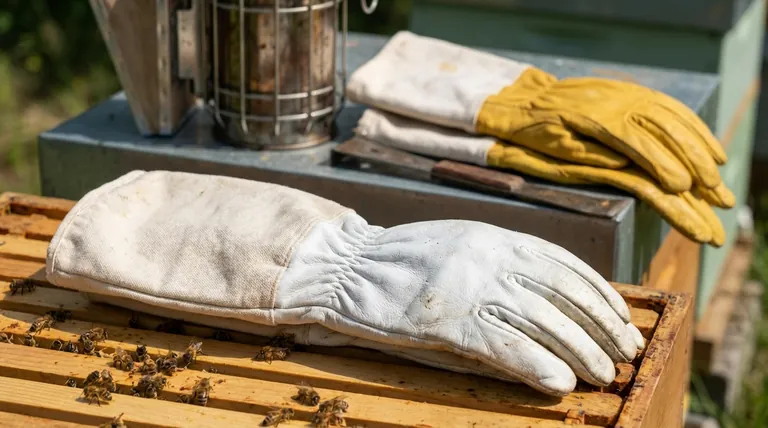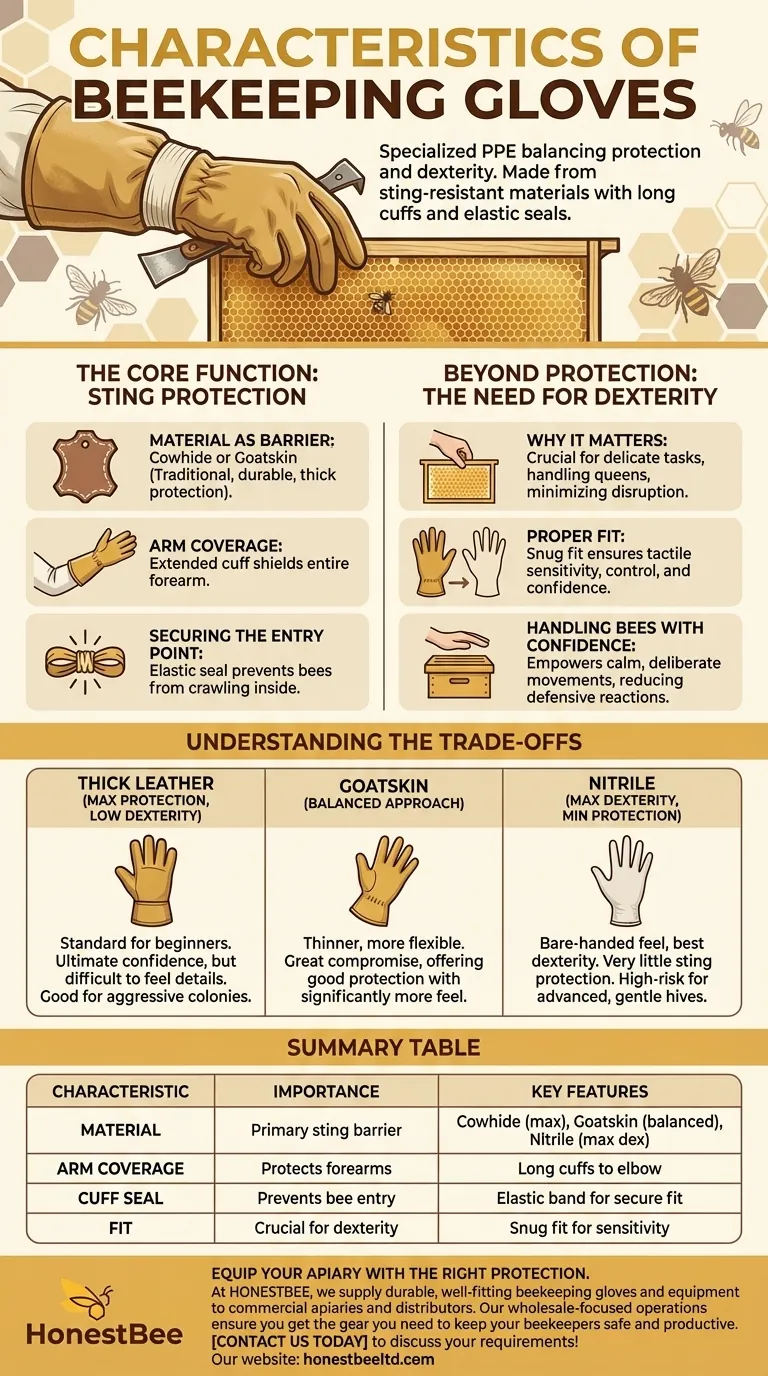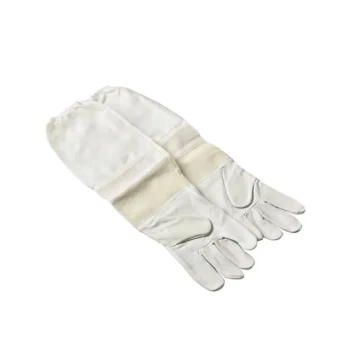At their core, beekeeping gloves are specialized personal protective equipment designed to shield your hands and arms from stings. They are typically made from thick, sting-resistant materials like leather or goatskin and feature long cuffs that extend to the elbow, secured with elastic to prevent bees from crawling inside. The design prioritizes protection while attempting to preserve as much manual dexterity as possible for handling frames and tools.
The central challenge in choosing beekeeping gloves is balancing protection against dexterity. While thick leather offers maximum safety, it reduces your ability to feel and work delicately, a trade-off every beekeeper must navigate based on their experience and the temperament of their hives.

The Core Function: Sting Protection
Beekeeping gloves are your first line of defense in an environment where stings are a constant possibility. Their design is focused on creating an impenetrable barrier between you and the bees.
Material as the Barrier
The primary material is chosen for its ability to resist a bee's stinger. Cowhide or goatskin leather is the traditional and most common choice due to its thickness and durability, offering the highest level of protection.
The Importance of Arm Coverage
A critical feature is the extended cuff or sleeve that reaches the elbow. This ensures that your entire forearm is covered, a common target area for stings when you are reaching deep into a hive.
Securing the Entry Point
Gloves feature an elastic band at the end of the cuff. This serves a vital purpose: to create a tight seal against your arm or over your bee suit, effectively eliminating any gaps where a bee could crawl inside.
Beyond Protection: The Need for Dexterity
While preventing stings is paramount, a beekeeper's work is often delicate. Your ability to feel and manipulate objects inside the hive is crucial for good management and the bees' well-being.
Why Dexterity Matters
You need to gently lift frames, inspect for tiny eggs, handle the queen, and use hive tools with precision. Bulky, ill-fitting gloves make these tasks difficult and increase the risk of accidentally crushing bees or dropping equipment, which can agitate the colony.
The Role of a Proper Fit
A snug fit is non-negotiable. Gloves that are too large have excess material at the fingertips, reducing your tactile sensitivity. A proper fit ensures you can work confidently and carefully, minimizing disruption to the hive.
Handling Bees with Confidence
The right gloves empower you to work with calm, deliberate movements. When you can feel what you are doing, you are less clumsy and less likely to provoke a defensive reaction from the bees, leading to a safer and more productive inspection.
Understanding the Trade-offs
No single glove is perfect for every situation. Your choice involves a direct trade-off between the level of protection you receive and the amount of dexterity you retain.
Thick Leather Gloves: Maximum Protection, Low Dexterity
These are the standard for beginners. The thick material provides the ultimate confidence against stings but makes it very difficult to feel small details within the hive. They are excellent for learning or when dealing with an aggressive colony.
Goatskin Gloves: The Balanced Approach
Goatskin is thinner and more flexible than cowhide. It represents a a great compromise, offering very good sting protection while allowing for significantly more feel and dexterity. Many experienced beekeepers consider this the ideal balance.
Nitrile Gloves: Maximum Dexterity, Minimal Protection
Some highly experienced beekeepers opt for heavy-duty disposable nitrile gloves. These offer the best possible dexterity, almost like working bare-handed, but provide very little protection against a determined sting. This is a high-risk, high-reward choice best reserved for gentle hives and quick, delicate tasks.
Selecting the Right Gloves for Your Needs
The ideal glove depends entirely on your experience level, the temperament of your bees, and the task you need to perform.
- If your primary focus is safety and building confidence as a beginner: Choose thick leather or goatskin gloves that offer maximum sting protection.
- If your primary focus is performing delicate hive inspections: Select a well-fitting pair of goatskin gloves that provide a balance of protection and dexterity.
- If your primary focus is maximum feel for advanced tasks (and you accept the risk): Consider using nitrile gloves for quick, sensitive work with a known gentle colony.
Choosing the right gloves is a critical step in ensuring you are a safe, confident, and effective beekeeper.
Summary Table:
| Characteristic | Importance | Key Features |
|---|---|---|
| Material | Primary sting barrier | Cowhide (max protection), Goatskin (balanced), Nitrile (max dexterity) |
| Arm Coverage | Protects forearms | Long cuffs extending to the elbow |
| Cuff Seal | Prevents bee entry | Elastic band for a secure fit over a bee suit |
| Fit | Crucial for dexterity | Snug fit to maximize tactile sensitivity and control |
Equip your apiary with the right protection. At HONESTBEE, we supply durable, well-fitting beekeeping gloves and equipment to commercial apiaries and distributors. Our wholesale-focused operations ensure you get the gear you need to keep your beekeepers safe and productive. Contact us today to discuss your requirements!
Visual Guide

Related Products
- Beekeeping Gloves Goatskin Leather with Long Cotton Sleeve for Beekeepers
- Goatskin Leather Beekeeper Gloves with Vent Long Sleeve for Beekeeping Honey Bee Sting Proof Protection
- Goat Skin Leather Bee Sting Proof Beekeeping Gloves with Canvas Sleeve
- Mesh Ventilated 3 Layer Goatskin Beekeepers Gloves for Beekeeping
- Professional Galvanized Hive Strap with Secure Locking Buckle for Beekeeping
People Also Ask
- What are the features of ventilated bee gloves? Stay Cool & Dexterous in Warm Weather
- Why is dexterity and flexibility important in beekeeping gloves? Boost Your Hive Management Efficiency
- Why are protective gloves important in beekeeping? Boost Confidence & Safety in Your Apiary
- What is the difference between cleaning cow leather and goat leather beekeeping gloves? Tailor Your Care for Longevity
- What are the advantages of goatskin leather gloves for beekeeping? Superior Sting Protection for Your Apiary



















